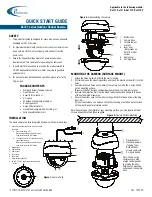
SBIG STC-428-OEM CAMERA
USER’S MANUAL
41
Appendix F: Concepts and Terminology
CCD
- A CCD (Charged Coupled Device) sensor is a flat, two dimensional array
of very small light detectors referred to as pixels. Each pixel acts like a bucket
for electrons. The electrons are created by photons (light) absorbed in the pixel.
During an exposure, each pixel fills up with electrons in proportion to the
amount of light entering the pixel. After the exposure is complete, the electron
charge for each pixel is shifted one at a time to an amplifier in one corner of
the chip. The resulting voltage is transferred to an external amplifier, filter, and
digital converter. When a pixel is displayed at the computer screen, its
displayed brightness is proportional to the number of electrons that had
accumulated in the pixel during the exposure.
CMOS
- A CMOS (Complementary Metal-Oxide Semiconductor) sensor is a flat,
two dimensional array of very small light detectors referred to as pixels. Each
pixel acts like a bucket for electrons. The electrons are created by photons
(light) absorbed in the pixel. During an exposure, each pixel fills up with
electrons in proportion to the amount of light entering the pixel. After the
exposure is complete, the electron charge at each pixel is amplified and
converted to a voltage by a tiny circuit at the pixel. The voltages from each
pixel are read out by built-in digital converters, often with one converter per
column, and the brightness values are read out from the sensor via a high-
speed digital interface. When a pixel is displayed at the computer screen, its
displayed brightness is proportional to the number of electrons that had
accumulated in the pixel during the exposure.
Color imaging with a monochrome camera -
One-shot Color (OSC) cameras
with a built-in Bayer matrix are handy for shooting quick color pictures
However, imaging with a monochrome camera provides the best quality,
sensitivity, and resolution.
A filter wheel with appropriate filters is used to create color images using a
monochrome camera. The simplest method is to use three filters, one for Red,
Green and Blue. Once the three images are captured, calibrated, aligned and
stacked, it is very simple to create the color composite image.
That is because images are
normally
stored as three red, green, and blue
planes. Your computer monitor simply displays the three colors directly and
your brain interprets different combinations of those three colors as a full
gamut of different colors. It works because the retina in the human eye itself is
based on red, green, and blue light-sensitive cells.
Dark Frame
- A Dark frame is an image taken completely in the dark. The
camera shutter must cover the sensor or the optical system must be capped to
prevent any light from reaching the sensor. Dark frames are subtracted from
normal exposures (light frames) to eliminate fixed pattern and dark current
noise from the image. Dark frames must typically be of the same integration
time and temperature as the light frame being processed.
Dark Current
–
Dark Current is the result of thermally-generated electrons
building
up in the sensor’s
pixels during an exposure. The number of electrons
due to Dark Current is related to two parameters, namely the integration time




































